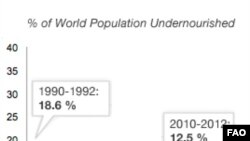LONDON —
The number of people going hungry around the world has declined over the past two decades, according to the United Nations Food and Agricultural Organization’s (FAO) 2012 report on food insecurity. But the report says in some regions -- including much of sub-Saharan Africa -- the numbers are shooting up.
The State of Food Insecurity in the World is a yearly hunger report published by the FAO, the International Fund for Agricultural Development and the World Food Program.
At a news conference in Rome Tuesday, FAO Director General José Graziano da Silva said 870 million people are hungry, which is a lower estimate than the organization has made in the last few years.
"We need to recognize that this number is still too high," said Da Silva. "One in eight people around the world are still hungry in a world of plenty that has enough food to feed all."
In 2009, the organization had estimated that a total of 1 billion people were hungry worldwide. Now the FAO has changed the way it collects data and says that figure was an over-estimate.
By re-tallying the data since 1990, the organization found that during the past 20 years, the number of hungry has actually gone down by more than 100 million.
Da Silva says that is good news. But since 2007, progress has been slowing.
"Several factors can explain that, most important the economic slowdown, which means less jobs and lower incomes," said Da Silva. "And also the high level of food prices and especially food price volatility that we have seen in the last years, which affects the poorest on the consumer side and the production side also."
The report also shows that progress is imbalanced, with some regions making huge leaps forward and others taking steps back.
In East Asia, the number of undernourished people has gone down by more than 80 million in the last 20 years. In Sub-Saharan Africa, the numbers have gone up by more than 60 million.
Kostas Stamoulis is director of the Agricultural Development Economics Division of FAO. He says the new system for tallying hunger rates means the statistics are more reliable. Stamoulis says the new methodology is based on a range of new figures, including updated population data, new statistics on calorie requirements, and better estimates on the amount of food that is actually available for consumption, rather than what is produced.
"FAO has the mandate and the responsibility to bring to its membership and the world community in general figures on hunger that reflect the latest progress on methodology and the latest available data," said Stamoulis. "So improving the way we calculate hunger, which is not something that was done in a short period of time, should enhance our credibility and should enhance the credibility of the data which we report."
Eight hundred 52-million of those who are hungry live in developing countries, the majority in South and East Asia and sub-Saharan Africa.
The State of Food Insecurity in the World is a yearly hunger report published by the FAO, the International Fund for Agricultural Development and the World Food Program.
At a news conference in Rome Tuesday, FAO Director General José Graziano da Silva said 870 million people are hungry, which is a lower estimate than the organization has made in the last few years.
"We need to recognize that this number is still too high," said Da Silva. "One in eight people around the world are still hungry in a world of plenty that has enough food to feed all."
In 2009, the organization had estimated that a total of 1 billion people were hungry worldwide. Now the FAO has changed the way it collects data and says that figure was an over-estimate.
By re-tallying the data since 1990, the organization found that during the past 20 years, the number of hungry has actually gone down by more than 100 million.
Da Silva says that is good news. But since 2007, progress has been slowing.
"Several factors can explain that, most important the economic slowdown, which means less jobs and lower incomes," said Da Silva. "And also the high level of food prices and especially food price volatility that we have seen in the last years, which affects the poorest on the consumer side and the production side also."
The report also shows that progress is imbalanced, with some regions making huge leaps forward and others taking steps back.
In East Asia, the number of undernourished people has gone down by more than 80 million in the last 20 years. In Sub-Saharan Africa, the numbers have gone up by more than 60 million.
Kostas Stamoulis is director of the Agricultural Development Economics Division of FAO. He says the new system for tallying hunger rates means the statistics are more reliable. Stamoulis says the new methodology is based on a range of new figures, including updated population data, new statistics on calorie requirements, and better estimates on the amount of food that is actually available for consumption, rather than what is produced.
"FAO has the mandate and the responsibility to bring to its membership and the world community in general figures on hunger that reflect the latest progress on methodology and the latest available data," said Stamoulis. "So improving the way we calculate hunger, which is not something that was done in a short period of time, should enhance our credibility and should enhance the credibility of the data which we report."
Eight hundred 52-million of those who are hungry live in developing countries, the majority in South and East Asia and sub-Saharan Africa.








